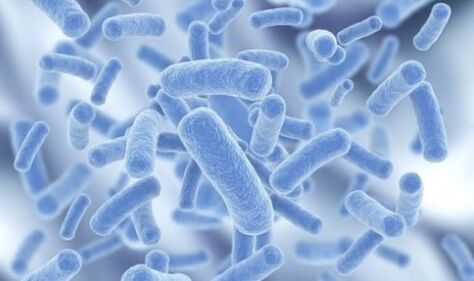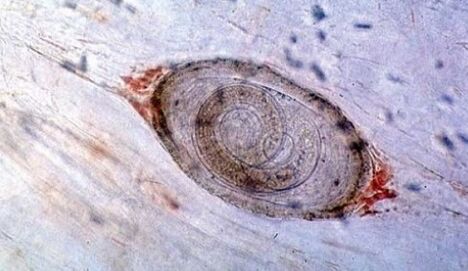Human parasites are called all organisms living at his expense. These are bacteria, fungus, worms. Human parasites are divided into internal and external. The most unpleasant and causing the largest number of destruction of the body are helminths - a variety of parasitic worms.

Parasites and human body
Creatures parasitizing on the human body can be external or internal. The external includes:
- Mosquitoes.
- Leeches.
- Lice.
- Microorganisms that cause scabies.
But there are much more creatures that prefer to settle inside the body. These include:
- Bacteria.
- Proper.
- Helminths.
- Fungal.
The external and internal organization of the parasite belongs to the simplest. Due to the fact that they do not need to evolve for the sake of survival, their organization is greatly simplified.
There are a lot of creatures that prefer to settle inside the body. For example, it can be bacteria.
They cannot survive without the host body, unable to get their own food. But they all breed, almost without exception, very quickly, especially in the conditions suitable for that. Where they are not driven from right away.
Differ territorially. Some can be found everywhere, no climate for them is an obstacle. Others live exclusively in tropical countries, but on the human body they can easily be brought to any others. In the body, they also settle in different places.

The cycles of the development of parasites, mainly helminths are also diverse. Some at first develop in the ground (Biohelminths), and then move to a living creature. Others must first develop in the body of any other living creature, but not a person. Third, in an adult state, you can transfer to another or re -infect yourself.
It is mistaken to assume that infection can occur exclusively through dirty hands. Eggs of some helminths are viable outside the nutrient medium for six months and cling to animal wool perfectly. Eggs survive in a dangerous environment for them - it is worthwhile to cook meat or fish incorrectly, as a whole brood of worms can be paid inside you.
It is worthwhile to cook meat incorrectly, how a whole brood of worms can be paid inside you.
Endoparasites of a person
Parasites are divided into Endoparasites and ectoparasites. Endoparasites - those that settle inside, Ecto - outside. Endoparasites are able to settle in almost all internal organs and body tissues. They are divided depending on localization. Endoparasites are:
- Connecting to the external environment of Endoparasites of internal organs.
They settled precisely in those organs that are connected to the external environment, not vice versa: the parasitic body is not chosen to "breathe". Such organs include the intestines, light, human urine system. These are amoebas, worms and burning parasitic.
- Parasites.
Set in human blood. They can live in plasma, white blood cells, red blood cells. These are tripanosomes, Microfilariae or Haemosporidia.
- Fabric Endoparasites.
Those endoparasites that choose the tissues of the body with their place of residence. Muscle tissue, brain, cartilage, connective. Even in nerve fibers, tissue Endoparasites can settle. These are fins of the strip worm, tripanosomes, myxosporidia, trichina and others.

Endoparasites can choose the brain with their place of residence.
Determination of the variety of parasite at the place of its localization is very conditional. Many species are able to migrate to various internal organs, regularly travel the owner’s body. The propagation process can occur in one place, and organisms will be directly and feed in another. The place where the parasite is justified and will be considered the place of its conditional localization.
Despite the simplification of many parasite systems, their life cycle is quite complicated.
Some varieties throughout their lives for survival have to change several owners who may relate to different biological species. Others are able to survive only one biological species inside, but they may require intermediate hosts. In one person, they multiply, and in another develop and grow up. With such a complex life cycle, their sexual functions are significantly increased. It is necessary to multiply for survival in the body parasites quickly and a lot.
Helminths
There are three main varieties of helminths, also called worms. This:
- Nematodes, they are round worms.
- Cestodes, endoparasites of tape shape.
- Trematodes, also known as saucers.
Next, they can be divided by the life cycle and the number of locations that they pass along this path. There are also three types:
GEO-Shelminths.
"Ge" is the Earth. These worms begin their existence in earthly soil, only after the maturation stage they can infect a person. They do not need intermediate hosts, eggs fall into the soil along with human feces. To the larval stage, they develop exclusively in the warm season.
Such worms include ascarides, intestinal ugritsy, a non -core, and the Blazo -heads.
Larvae of these parasites can get into the human body through unwashed vegetables or direct contact with the soil.
Biohelminths.
These are parasitic worms, the stages of life of which pass through several owners. Intermediate hosts can be two or more depending on the variety of worms. Some parasites change exclusively a person. Others, before finally getting into the human body, are used by organisms of other biological creatures for development.

You can infect through pets or in contact with other people, also when consuming half -dried meat. Biohelminths include bull tapeworms, echinococcus, wide tape, trichina and others.
Contagioine helminths.
These worms do not need any soil or intermediate owners. They pass all the stages of their life cycle in one organism, very comfortably located. Larvae stand out directly from the human body, when contacting household surfaces and other people, spreading freely.
Helminants can live in different organs and systems of the human body, periodically migrating from one part of the body to another.
The list of diseases caused by helminths is very extensive. Determine which parasites live in the body and what treatment can be started only after all the analyzes necessary for establishing the type are passed.
Round worms
The most widespread in the human environment were round worms, also known as Nematodes. In total, there are more than 24 thousand types of nematodes in the world.
They are round because of their shape, which is detected if you make a transverse cut. The most common human nematodes:
- Askarids.
- Speakers.
- Trichina.
- Blacovyv.
The helminthic invasion, known as ascariasis, begins with direct contact with the soil infected larvae or when using unwashed fruits and vegetables. Parasites begin to develop in the intestines, then they enter the circulatory system of a person, from where they go to different internal organs, heading to the oral cavity. A person, not noticing this, repeatedly swallows an adult parasite. They feed on the remains of undigested food. The waste of the ascaris is extremely toxic. There is no vaccine from ascariasis, infection can be prevented exclusively by observing the rules of personal hygiene.
Pinworms infection is called Enterobiasis. These are small worms (5-10 mm) attached to the walls of the intestine. They feed on blood and contents of the intestine. They put their eggs under the skin, getting out of the anal opening outside while the owner is sleeping. Due to itching, a person combs anal region, larvae fall under the skin and hands, can be easily transferred to other people in the house or in public places. Enterobiosis does not have painful symptoms, detecting PinWorms infection at the initial stage is extremely problematic.
Trichinella, they are Trichina, these are round worms that choose an animal or person with their master.

Trichinella is a parasitic worm that affects the human body, causing a dangerous Vermis disease of trichinellosis.
They begin to develop in the area of the cross-striped muscles in the body, then redirect to the small intestine. In advanced cases of infection per kilogram of muscle tissue, about 15 thousand Trichinella eggs can be located. These parasites can cause a deadly disease, named after its source - trichinellosis.
Round worms of the Blazovians are called so because of their appearance. The front part of their body is a filament, it contains one esophagus.
The back is wider, the remaining internal organs of the parasite are located in it. The length of the Blazoles can reach 50 mm. It feeds on blood, as well as tissue fluid. Causes the disease of trichocephalosis.
Ribbon worms
In the world there are about 3, 500 species of famous strip worms, the type of which is also called CESTODES. There are no digestive systems in these flat worms at all, and the diseases that they cause are called CESTODOSIS.
The most common cestodossis:
Cystystyrkosis.
The disease of the larvae of pork tapeworm is excited, entering inside polluted food, from dirty hands.
The disease affects the skin, bones, internal organs, brain and spinal brain. Most often, parasites are sent to the brain (in 60% of infection cases). It is diagnosed based on the appearance of rounded formations on the skin. The disease is treated, in case of infection of the central nervous system, forecasts can be unfavorable.
Echinococcosis.
Localized in the liver, lungs, many other internal organs. Echinococcus larvae excite the disease. They can develop within a person for several years.
Infection occurs in contact with animals, collecting berries and fruits, consumption of contaminated water. The disease is not too noticeable, it can develop for years, and it is revealed only by accident.
AlveoCocoscosis.
AlveoCocosis is caused by AlveoCococcus worms. The disease is similar to Echinococcosis, but proceeds in more severe. It affects the lungs and kidneys. Without the treatment of the disease, there is a great probability of fatal outcome in connection with the development of liver failure.
Toniarynchosis.
The tusiarinchosis is caused by a bull chain. Parasitizes the tapeworm in the area of the small intestine, develops for 2. 5-4 months. Forecasts are more often favorable for treatment. Parasites can get into a person with infected raw or insufficiently treated thermally meat.
Ribbon worms are very fertile. They have the most reduced the rest of the sensitivity and there is no digestive system at all. Such parasites are not able to develop without the owner.
Sosal workers
Supreme is tremontodes. These are flat worms, in the shape of your body resembling an oblong leaf of a tree.
Some types of Trematodes can reach one and a half meters in size.
And they find themselves in the human body, they are most often through fish or other seafood. About 7200 types of Trematodes are known, 40 of them settle in people and cause trematodoses, serious diseases caused by infection.
The most common salars:
The hepatic bicom.
Globally common, can exist in animals and people. The biological life cycle is complex, the parasite changes the owners.

Schistosoma.
Schistosome larvae can penetrate the skin or mucous membrane. The life cycle is complex, feed on blood. One female is able to produce about 3, 000 eggs per day, the fertility of these parasitic worms is very high.
Other liver balemers.
Opisthorchiasis, Helminth disease, spreading for the most part in the liver. The human body has a toxic effect.
The digestive system of wormworms is well developed, and with it-sexual and Excretory. The rest of the systems develop poorly. Tremontodes feed on blood, epithelial skin cells, the contents of the intestine. They can dwell almost anywhere: from the liver to conjunctival eyes of eyes.
Other types of endoparasites
The remaining internal parasites are a variety of bacteria that cause dangerous diseases, and with them the simplest microorganisms. The fungus that spreads inside the human body also refers to the section of endoparasites.
Many useful and harmful microorganisms live in the human body. Some of them cause quite dangerous diseases that can lead to death. It is not always possible to immediately recognize the presence of parasitic creatures within yourself, but the early diagnosis of infection gives more chances to complete cure. If the invasion is suspected, it is recommended to quickly undergo a complete examination by a doctor.























